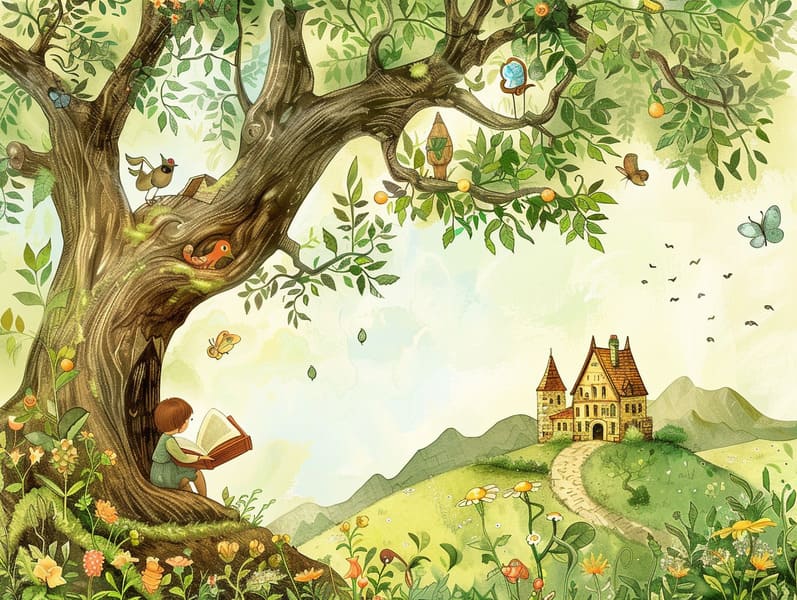Embracing the Enchantment of Nightfall Fairy Tales: Creating Treasured Experiences with Kids
Embracing the Enchantment of Nightfall Fairy Tales: Creating Treasured Experiences with Kids
Blog Article

Nighttime is a precious time for parents and children. It’s a moment to calm down, nestle in, and experience the wonder of bedtime narratives.
For generations, stories for kids at bedtime have been a prized ritual, offering more than just a way to nod off. They provide an moment for connection, discovery, and fueling imagination.
The Importance of Bedtime Stories
Evening stories for little ones are more than just a way to end the day. They play a vital role in a child’s development and in nurturing the caregiver-child link. Here’s why they are beneficial:
1. Closeness Moments: Storytime before sleep strengthens a special loving connection between moms and dads with their little ones. It’s a moment of togetherness that helps children feel cherished and reassured.
2. Language Skills: Being read to helps children develop their linguistic abilities. They understand new vocabulary, understand syntax, and refine their understanding and grasping abilities.
3. Imagination and Creativity: Narratives for little ones transport them to dreamy worlds, encouraging imagination. They envision characters, settings, and adventures, which ignites their fantasy.
4. Feeling Recognition: Stories for little ones often include characters facing challenges and emotions. These plots help kids interpret and process their own feelings, encouraging emotional intelligence.
5. Brain Growth: Paying attention to a narrative helps children develop mindfulness, retention, and thought processes. They enhance to follow lines of thought, remember elements, and guess endings.
Making Stories a Bedtime Habit
Establishing a bedtime habit that features reading narratives is simple and beneficial. Here’s how to turn it into a cherished part of your nightly custom:
1. Pick a Snuggly Spot: Pick a snug place where you and your child can snuggle up without intrusions. A snug bed or a cozy reading nook works great.
2. Choose a Set Time: Pick a set time each night for storytime. Regularity helps children be ready and makes the tradition simpler to continue.
3. Pick Age-Suitable Stories: Choose tales that suit your child’s interest level. Preschoolers might be engaged by illustrated books with easy plots, while more mature kids may be drawn to detailed stories with more involved stories.
4. Make the Story Interactive: Try to the tale be captivating by employing different character voices, adding effect sounds, and inviting your child to be involved. Ask questions about the story to keep them listening.
5. Make a Calm Setting: Dim the lights, use gentle voices, and create a peaceful environment to help your child get ready for sleep.
Where to Find Bedtime Stories
There are many places where you can find fantastic bedtime stories for children. Here are some choices to check out:
1. Kids’ Literature: Explore your area library or bookstore to find a broad selection of bedtime stories for kids. Going through the shelves together can be a delightful activity that also helps children to get stories that they like.
2. Internet Sources: There are many sites that offer free bedtime stories. Sites like children's story websites provide a variety of short stories for kids that you can access. These choices are great for finding new and assorted stories without cost.
3. Apps and Audiobooks: For nights when you’re too worn out to read, think about audiobooks or storytelling apps. These can provide a gentle reading to read your child a story, ensuring they still get their bedtime story fix. Apps often offer fun elements that can keep them engaged further.
4. Unique Stories: Create your own stories reflecting your child’s interests. Personalized stories can be highly engaging and meaningful. You can get your child in the creation process, making them a part of the adventure.
Why Shorter Stories Are Best
Short stories for kids are particularly effective for bedtime. They provide all the good aspects of longer stories but are more short, making them perfect for preparing for sleep before sleep. here Here’s why short stories are a good choice:
1. Clear and Simple: Concise narratives are simple and easy for kids to get, even after a long day. They can readily grasp the line and enjoy the story without getting lost.
2. Fast Engagement: These stories swiftly engage children, grabbing their engagement and interest. This makes them ideal for keeping bedtime habits smooth yet enjoyable.
3. Wide Range: To-the-point tales create for variety in your bedtime storytime. You can select a different story each night, keeping the practice fresh and exciting for your child.
4. Efficient Use of Time: For busy parents, quick stories are a time-efficient way to verify children still get their nightly dose of storytelling. They fit well into a busy schedule while still offering the full benefits of a bedtime story.
The Appeal of "Read Me a Story"
The simple phrase, “Can you read to me?” can unlock a world of magic for children. Saying yes to this request not only fulfills a child’s need for attention and engagement but also creates lasting recollections. Here’s why it’s charming:
1. Tie: Sharing stories to your child encourages a deep emotional attachment. It’s a time for attachment, sharing, and bonding.
2. Custom: Forming a bedtime story ritual creates a important tradition that children are excited for every night. It’s a routine that can be continued through generations.
3. Growing Together: As you read aloud, you’ll see your child’s advancement and advancement. Their queries, reactions, and understanding of the stories develop, offering insights into their developing minds.
4. Safe Environment: Bedtime stories provide a safe space for children to deal with emotions, face fears, and find comfort in the familiar presence of a parent.
Closing Thoughts
Stories for kids at bedtime are a important tool for encouraging a child’s development and developing unforgettable times of closeness.